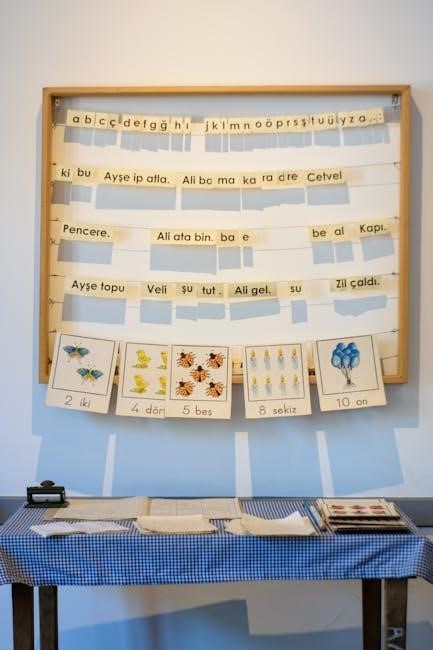classroom behavior report card resources book.pdf
The Classroom Behavior Report Card Resources Book is a comprehensive guide designed to help teachers assess and manage student behavior effectively. It provides customizable templates‚ detailed tracking tools‚ and practical strategies to promote positive classroom behavior and clear communication between educators‚ students‚ and parents.

Understanding the Importance of Behavior Report Cards in the Classroom
The Classroom Behavior Report Card plays a vital role in maintaining a structured and productive learning environment. It helps teachers identify and address behavioral issues early‚ ensuring students meet classroom expectations. By providing clear feedback‚ these reports foster accountability and encourage positive behavior. They also serve as a communication tool between educators and parents‚ promoting collaboration in supporting student growth; Regular use of behavior report cards can lead to improved focus‚ reduced disruptions‚ and a more conducive atmosphere for academic success.

Structure and Content of the Classroom Behavior Report Card Resources Book
The Classroom Behavior Report Card Resources Book is a comprehensive‚ organized guide offering pre-formatted templates‚ customizable graphs‚ and practical examples to assess and track student behavior effectively.
Teacher Behavior Report Cards: Features and Benefits
The Teacher Behavior Report Cards in the resource book offer customizable templates and detailed tracking tools to monitor classroom behavior effectively. These cards provide clear feedback mechanisms‚ enabling teachers to identify behavioral patterns and address concerns promptly. They also include sections for goal-setting and progress monitoring‚ fostering accountability and improvement. The structured format ensures consistency in assessment‚ while customizable features allow educators to tailor the reports to specific classroom needs‚ enhancing communication with students and parents for better outcomes.
Student Behavior Report Cards: Tools for Self-Assessment
Student Behavior Report Cards serve as powerful tools for self-assessment‚ enabling students to reflect on their actions and take ownership of their behavior. These cards provide daily or weekly tracking of behaviors‚ allowing students to identify strengths and areas for improvement. Customizable templates encourage goal-setting and accountability‚ while fostering a growth mindset. By involving students in their own behavior management‚ these tools promote self-awareness and responsibility‚ creating a foundation for positive behavior and improved classroom outcomes. They also align with classroom expectations‚ fostering a proactive approach to behavior management.
Customizable Templates for Behavior Tracking
The Classroom Behavior Report Card Resources Book provides customizable templates designed to streamline behavior tracking. Teachers can adapt these templates to suit individual classroom needs‚ ensuring alignment with specific behavioral goals. Features include pre-formatted rating scales‚ daily tracking charts‚ and progress monitoring tools. These templates enable educators to document behavior consistently‚ identify patterns‚ and set actionable goals for improvement. By offering flexibility and structure‚ they support effective behavior management and foster a positive learning environment tailored to diverse student needs and classroom dynamics.
The Role of Behavior Report Cards in Classroom Management
Behavior report cards play a crucial role in classroom management by monitoring student conduct and fostering a structured environment. They help establish clear expectations‚ encourage positive behavior‚ and facilitate communication between teachers‚ students‚ and parents.
Proactive Strategies for Managing Classroom Behavior
Proactive strategies for managing classroom behavior involve setting clear expectations‚ using behavior charts‚ and implementing incident reports. These tools help teachers address issues before they escalate‚ fostering a structured environment. By establishing consistent routines and positive reinforcement‚ educators can encourage responsible behavior and reduce disruptions. The Classroom Behavior Report Card Resources Book provides templates like daily point charts and behavior contracts to support these efforts‚ ensuring students stay focused and productive while maintaining a respectful classroom atmosphere.
Using Behavior Report Cards to Monitor Student Conduct
Behavior report cards are essential tools for monitoring student conduct‚ providing clear and consistent feedback. They help teachers track daily behavior‚ identify patterns‚ and address challenges promptly. The Classroom Behavior Report Card Resources Book offers customizable templates‚ including daily behavior charts and incident reports‚ to document student actions effectively. These tools enable educators to maintain consistency‚ communicate with parents‚ and foster a structured learning environment. Regular use of these resources ensures that behavioral expectations are met and supports overall classroom management.
Creating a Positive Classroom Environment Through Feedback
Behavior report cards play a vital role in fostering a positive classroom environment by providing constructive feedback. They help students understand expectations and improve their conduct. The Classroom Behavior Report Card Resources Book offers tools to deliver consistent‚ clear feedback‚ encouraging self-reflection and growth. By highlighting strengths and areas for improvement‚ educators can create a supportive atmosphere that promotes engagement and responsible behavior‚ ensuring students feel valued and motivated to succeed.

Real-World Applications of the Classroom Behavior Report Card
The Classroom Behavior Report Card is a practical tool for tracking student behavior‚ improving productivity‚ and reducing disruptions‚ ensuring a focused and respectful learning environment for all students.
Improving Student Productivity and Reducing Disruptions
The Classroom Behavior Report Card plays a crucial role in enhancing student productivity and minimizing disruptions. By providing clear expectations and immediate feedback‚ it helps students stay focused and engaged. Daily behavior tracking tools‚ such as point systems and incident reports‚ allow teachers to identify and address issues promptly‚ fostering a more orderly learning environment. This proactive approach not only boosts academic engagement but also encourages students to take responsibility for their actions‚ leading to a more productive and respectful classroom atmosphere overall.
Case Studies: Successful Implementation of Behavior Report Cards
Case studies highlight the effectiveness of behavior report cards in improving classroom dynamics. For instance‚ the Good Behavior Game significantly reduced disruptive behaviors and improved student focus. Similarly‚ daily behavior report cards (DBRCs) have shown success in increasing productivity and reducing rule violations. These real-world examples demonstrate how structured behavior tracking and feedback systems can lead to positive outcomes‚ fostering a more disciplined and engaged learning environment for students.

Tips for Effective Implementation of Behavior Report Cards
Effective implementation involves clear expectations‚ consistent reporting‚ and parent involvement. Digital tools simplify tracking‚ ensuring timely feedback and positive behavior reinforcement. This approach fosters accountability and growth.
Ensuring Clarity and Consistency in Behavior Reporting
Clarity and consistency are achieved by using standardized templates and objective criteria for assessing behavior. This ensures fairness and accuracy in reporting‚ avoiding subjective biases. By aligning behavior ratings with classroom expectations‚ educators provide clear feedback‚ helping students understand their progress. Training teachers on consistent reporting practices and maintaining open communication with parents further enhance reliability. Regular updates and aligned criteria ensure behavior reports remain focused and relevant‚ fostering a transparent and equitable assessment process.
Collaborating with Parents and Guardians for Better Outcomes
Collaboration with parents and guardians is essential for fostering positive student behavior. The Classroom Behavior Report Card Resources Book provides tools like daily behavior report cards and parent-teacher conference guides to ensure consistent communication. By sharing detailed feedback‚ educators enable parents to reinforce positive behaviors at home. This partnership creates a unified approach to supporting students‚ promoting accountability‚ and fostering a collaborative environment for better academic and behavioral outcomes. Regular updates and transparent reporting further strengthen this vital relationship.
Cultural Sensitivity in Assessing and Reporting Student Behavior
Cultural sensitivity is crucial when assessing and reporting student behavior. The Classroom Behavior Report Card Resources Book emphasizes the importance of understanding diverse backgrounds and avoiding biases. It provides customizable templates that account for cultural differences‚ ensuring fair and inclusive evaluations. Teachers are encouraged to use clear‚ non-judgmental language and consider individual student needs. This approach fosters mutual respect and ensures that behavior assessments are equitable and aligned with students’ unique cultural contexts‚ promoting a more inclusive learning environment.

The Connection Between Behavior Report Cards and Academic Performance
The connection between behavior report cards and academic performance is significant‚ as positive behavior fosters better focus‚ engagement‚ and improved academic outcomes by addressing learning barriers effectively.
How Behavior Impacts Academic Focus and Engagement
Positive classroom behavior significantly enhances academic focus and engagement by creating a conducive learning environment. Students who exhibit consistent good behavior tend to stay concentrated‚ participate actively‚ and demonstrate better overall performance. Conversely‚ disruptive behavior can hinder focus‚ reduce engagement‚ and negatively impact academic outcomes. By addressing behavioral challenges through report cards‚ educators can identify patterns‚ provide targeted support‚ and help students develop self-regulation skills‚ ultimately fostering improved academic motivation and success. This connection underscores the importance of behavior management in education.
Using Report Cards to Identify and Address Learning Barriers
Behavior report cards serve as valuable tools for identifying learning barriers by tracking patterns of behavior that may indicate underlying academic challenges. By monitoring student conduct and performance‚ educators can pinpoint areas where students struggle‚ such as difficulties with focus or task completion. This data enables teachers to provide targeted support and interventions‚ ensuring students receive the resources they need to overcome these barriers and succeed academically. Regular feedback through report cards fosters collaboration between teachers and parents‚ further addressing these challenges effectively.
Strategies to Improve Academic Motivation Through Behavior Management
Effective behavior management strategies‚ such as positive reinforcement and clear expectations‚ can significantly enhance academic motivation. By aligning behavior goals with academic objectives‚ teachers create an environment where students are encouraged to stay focused and engaged. Tools like behavior report cards provide actionable feedback‚ helping students understand how their conduct impacts learning. Incentivizing good behavior and offering consistent support fosters a growth mindset‚ promoting both academic success and personal development.

Addressing Challenges and Limitations of Behavior Report Cards
While behavior report cards are valuable‚ challenges like subjective ratings‚ language barriers‚ and resource intensity can limit their effectiveness‚ requiring careful implementation and adaptation.
Ensuring Objectivity in Behavior Assessments
Ensuring objectivity in behavior assessments is crucial for fairness and accuracy. The resource book provides clear criteria and examples to minimize subjective bias. Teachers can use specific behavioral indicators and rubrics to evaluate student actions consistently. Training and collaboration among educators help maintain uniform standards. Incorporating observable and measurable behaviors reduces personal interpretations‚ ensuring assessments are reliable and equitable for all students. Regular reviews and feedback mechanisms further enhance the objectivity of the behavior reporting process.
Managing the Resource Intensity of Behavior Reporting Systems
Managing the resource intensity of behavior reporting systems requires balancing detailed tracking with practicality; The Classroom Behavior Report Card Resources Book offers tools like daily point charts and incident reports to streamline documentation. Teachers can customize templates to focus on specific behaviors‚ reducing administrative workload. Digital tools and pre-formatted graphs simplify data collection and analysis‚ ensuring efficient use of time and resources. This approach helps educators maintain thorough records without overwhelming their workload‚ making behavior management sustainable and effective.
Overcoming Language Barriers in Behavior Communication
The Classroom Behavior Report Card Resources Book addresses language barriers by providing customizable templates that can be translated into students’ native languages. This ensures clear communication between teachers‚ students‚ and parents. Digital tools within the resource allow for multilingual support‚ making behavior reporting accessible to diverse populations. By breaking down language obstacles‚ educators can ensure consistent understanding and foster positive behavior management across all students‚ regardless of their linguistic background.

Success Stories and Testimonials from Educators
Educators praise the resource book for its positive impact‚ sharing testimonials of improved student behavior and enhanced academic focus through effective behavior management strategies.
Case Studies Highlighting Positive Outcomes
Case studies reveal significant improvements in classroom behavior and academic engagement following the implementation of the Classroom Behavior Report Card Resources Book. One school reported a 30% reduction in disruptions‚ while another saw increased student productivity. Teachers noted improved focus and engagement‚ with students taking greater responsibility for their actions. The resource book’s tools‚ such as daily behavior tracking charts‚ helped create a more positive and structured learning environment‚ fostering better communication between educators‚ students‚ and parents.
Quotes and Feedback from Teachers Using the Resource Book
Teachers praise the Classroom Behavior Report Card Resources Book for its practicality and effectiveness. One educator noted‚ “This book transformed how I manage behavior in my classroom.” Another shared‚ “The customizable templates and tracking tools have been incredibly helpful.” Feedback highlights how the resource fosters positive student behavior‚ improves communication with parents‚ and streamlines classroom management. Educators appreciate the clarity and structure it brings to assessing and addressing behavioral challenges‚ making it an invaluable tool for creating a productive learning environment.

Digital Tools and Resources for Behavior Report Card Integration
The Classroom Behavior Report Card Resources Book integrates seamlessly with digital tools‚ offering software and apps to streamline behavior reporting. Customizable templates enhance communication between teachers‚ students‚ and parents‚ ensuring consistent and effective behavior management.
Software and Apps for Streamlining Behavior Reporting
Digital tools like Behavior Snap and ClassDojo offer innovative solutions for creating and managing behavior report cards. These apps enable teachers to track student behavior in real-time‚ generate detailed reports‚ and share progress with parents effortlessly. Customizable templates and automated scoring simplify the reporting process‚ ensuring accuracy and efficiency. Additionally‚ these platforms provide data analytics to identify trends and support proactive behavior management strategies. By integrating these tools‚ educators can enhance communication and maintain a consistent approach to monitoring student behavior effectively.
Combining Digital and Traditional Methods for Effective Management
Blending digital tools with traditional methods creates a balanced approach to behavior management. Digital platforms like ClassDojo offer real-time tracking and instant feedback‚ while traditional charts and report cards provide tangible records. This hybrid system ensures consistency‚ enhances communication with parents‚ and caters to diverse learning needs. By integrating both approaches‚ educators can streamline data collection‚ improve accuracy‚ and foster a collaborative environment for student growth and positive behavior development.

Future Trends in Classroom Behavior Management and Reporting
Future trends emphasize AI-driven analytics for real-time behavior monitoring‚ personalized feedback systems‚ and data-driven decision-making to enhance classroom management and reporting efficiency.
The Role of Technology in Advancing Behavior Management
Technology is revolutionizing classroom behavior management through innovative tools like AI-driven analytics‚ real-time tracking apps‚ and customizable digital report cards. These solutions enable teachers to monitor behavior more efficiently‚ providing instant feedback and actionable insights. Digital platforms also facilitate seamless communication with parents and students‚ fostering collaboration and transparency. By integrating technology‚ educators can create a more responsive and data-driven approach to managing classroom behavior‚ ultimately enhancing student outcomes and academic success.
Emerging Strategies for Holistic Behavior Assessment
Emerging strategies for holistic behavior assessment emphasize a multi-faceted approach‚ combining traditional methods with modern tools. Customizable templates and daily behavior reports allow teachers to track patterns over time‚ while graphs provide visual insights into student progress. This approach encourages students to reflect on their actions and set personal goals. By incorporating feedback from both educators and parents‚ these strategies foster a collaborative environment that supports individual growth and accountability‚ ensuring a well-rounded understanding of student behavior.
The Classroom Behavior Report Card Resources Book is an essential tool for fostering positive behavior and effective classroom management. By providing customizable templates‚ tracking tools‚ and actionable insights‚ it empowers educators to create a supportive learning environment and promote student growth. This resource is a valuable investment for teachers seeking to enhance behavior management and communication‚ ensuring long-term success for students and educators alike;
Summarizing the Value of the Classroom Behavior Report Card
The Classroom Behavior Report Card offers a comprehensive approach to assessing and managing student behavior‚ providing clear communication between teachers‚ students‚ and parents. Its customizable templates and actionable insights help educators identify behavioral strengths and areas for improvement. By promoting transparency and consistency‚ it fosters a positive learning environment and supports academic success. This resource is invaluable for creating structured‚ goal-oriented behavior management systems that benefit both students and educators‚ ensuring long-term positive outcomes in the classroom.
Encouraging Continued Professional Development in Behavior Management
The Classroom Behavior Report Card Resources Book serves as a valuable tool for educators to enhance their skills in behavior management. By providing customizable templates and strategies‚ it encourages teachers to reflect on their practices and explore innovative approaches. The book also fosters collaboration with peers and supports ongoing learning‚ ensuring educators stay updated on best practices. This resource not only aids in managing student behavior but also empowers teachers to grow professionally‚ creating a positive and dynamic classroom environment.












Leave a Comment